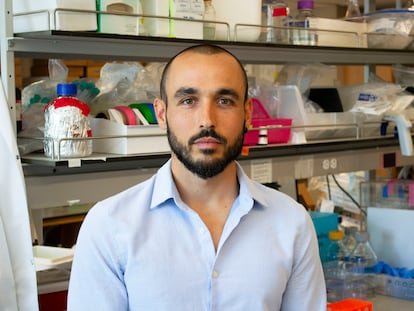Research opens the door to early detection of breast cancer through breast milk
For the first time, a study has detected tumor DNA in the breast milk of patients with breast cancer. The researchers involved propose a liquid biopsy of this fluid, as a tool for early diagnosis of the disease

Some time ago, a woman with breast cancer gave her doctor — oncologist Cristina Saura — some samples of her breast milk, which she had frozen 18 months before the diagnosis. The tumor was detected when she was pregnant with her third child. The woman feared she had transmitted the disease through breast milk to her second daughter, whom she breastfed until shortly before she became ill.
Saura and her team knew that tumors cannot be transmitted through breastfeeding, but due to the patient’s concern, “a light bulb went on,” the oncologist explains. Perhaps, in that milk sample, there were already signs of cancer. Indeed, this was the case: in the milk, frozen many months before the cancer diagnosis, there was already tumor DNA that revealed the presence of cancer in the body.
In a subsequent study with 15 patients that was published in the journal Cancer Discovery, Saura and her team at the Vall d’Hebron Oncology Institute (VHIO) in Barcelona confirmed the presence of tumor DNA fragments in the breast milk. The research has opened the door to using the analysis of this fluid as a tool to diagnose breast cancer early in the postpartum period.
The liquid biopsy technique has shaken up cancer research. This diagnostic approach consists of searching the body’s fluids — especially the blood — for signs or traces of a tumor before it shows its face. In this way, with a particular type of blood test, for example — one that is much less invasive than a traditional biopsy — the presence of tumors (that are still invisible) can be detected.
Liquid blood biopsies have already been utilized to test for colon or breast cancer, as have cerebrospinal fluid biopsies in brain tumors, urine biopsies in bladder neoplasms, or saliva biopsies in oral cancer. Breast milk is the latest body fluid in close contact with a tumor that now shows its potential in the early diagnosis of the disease. It offers a lot to researchers during a particularly complex stage, such as the postpartum period.
The finding lands in the fields of pregnancy and lactation, where all the variables play against each other in the incidence of the disease. Breast cancer is most commonly detected during these stages. “Breast tumors diagnosed in the postpartum or pregnancy represent up to 55% of tumors diagnosed in women under the age of 45,” Saura warns. Taking into account that aging increases the risk of this disease and that there is a tendency to delay pregnancy in developed countries, it’s likely that “cases will increase in the coming years,” according to the study.
In addition to the fact that the incidence of breast cancer is increasing, in this context, breast cancer usually involves a complex diagnosis and, sometimes, a more unfavorable prognosis: there is no screening technique available for people under the age of 50. Hence, these tumors are usually detected later on in life.
The sensitivity of diagnostic imaging tests during pregnancy may be lower, due to the changes suffered by the mammary glands. Symptoms may also be underestimated by patients and professionals. Furthermore, tumors diagnosed postpartum tend to be more aggressive, due to changes in the breast once breastfeeding is stopped, as explained by the experts consulted.
Following the request of Saura’s patient, the Vall d’Hebron researchers began a study. They analyzed breast milk and blood samples from 15 women with breast cancer and another dozen healthy volunteers. “In the women who had breast cancer diagnosed during pregnancy or breastfeeding, we found tumor DNA circulating in their breast milk. In 13 of the 15 patients, the [milk] samples were positive,” explains Saura, who is head of the Breast Cancer Unit at Vall d’Hebron Hospital and head of the VHIO Breast Cancer Group. In the other two female patients, the samples collected were colostrum (first milk). The researchers suspect that their tests were negative because the tumor DNA didn’t have enough time to come into contact with this fluid.
“It takes several days for the DNA to be released from the cells. We believe that [with colostrum], not enough milk has been produced to carry tumor DNA,” the oncologist affirms. The frequencies of the variants detected in colostrum, in fact, were “almost seven times lower compared to those collected after 14 days of lactation and considered to be mature samples,” the study states. In the analyses of the milk of the healthy volunteers, no traces of the tumors were found.
The researchers also found that the sensitivity of breast milk tests was higher than that of blood samples, which were almost all negative. “It was expected,” says Saura, because, in breast cancer, to find tumor DNA in a liquid blood biopsy, a high burden of disease is needed, for instance, when there’s metastasis. “With a localized tumor, the amount of tumor DNA in the blood is always low. On the other hand, in milk, we’re already able to detect tumor DNA,” the oncologist explains.
Towards an early-diagnosis test
With the study, scientists have demonstrated — for the first time — that the breast milk of breast cancer patients carries enough tumor DNA to detect it through a liquid biopsy, even before the diagnosis can be made with conventional imaging tests. Dr. Saura points out that the results of the study open the door to developing an early-diagnosis test in the postpartum period, in women who decide to breastfeed. However, she admits that this finding is still the first step.
Teresa is one of the participants in the study. Her case — like that of the first patient who triggered the investigation — illustrates the potential of this detection technique. She was healthy when she became pregnant, but she was 46-years-old. Due to the risk factor of her age, she wanted to participate in the study. “Eighteen months [after my child was born], in one of the trial controls [a follow-up breast ultrasound] they detected the tumor and I put myself in their hands. Since it was detected at an early stage, no chemotherapy was necessary. I had surgery and received radiotherapy,” explains the 50-year-old woman, who spoke to EL PAÍS by phone. In the analysis of breast milk samples taken during the trial, 11 months after delivery — that is, half-a-year before the diagnosis via breast ultrasound — fragments of tumor DNA were already visible. Hence, with this technique, the diagnosis could have been brought forward six months, as argued by the authors of the study.
The research is still ongoing. To realize the full potential of their discovery, Saura and her team have also developed a gene panel, which contains the most frequent mutations present in women diagnosed with breast cancer before the age of 45. As occurs with the heel prick test in babies to detect congenital metabolic ailments, this panel — which will be used to analyze breast milk samples — could also function as an early diagnosis method in the postpartum period, the researchers predict. “The third step — for this to translate into a useful early diagnosis test — is to demonstrate it. We’re going to do a study that will include 5,000 healthy women at risk of breast cancer (over 40 years of age and/or with a genetic predisposition) from whom a blood sample will be taken, as well as another milk sample from each breast. They will undergo an ultrasound and will be followed up for two years,” Saura details.
Joan Albanell — the head of Oncology at the Hospital del Mar in Barcelona, who didn’t participate in the research — calls the study “innovative.” “At a clinical level, the impact has yet to be determined, but it’s a conceptual advance,” he agrees. The doctor highlights that — according to this study — breast milk “is a more reliable source for detecting circulating tumor DNA” and, with liquid biopsy, “the diagnosis can be moved up.” But Albanell is cautious about the timing: “To see if this can be translated into systematic patient screening, multicenter studies are needed to validate the value and efficiency of the technique.”
Saura insists that, “if everything goes well, there will be a new tool for the early detection of breast cancer in the postpartum.” In practice, specifically, this can mean an improvement in prognosis and survival, because tumors can be “detected when they are localized” in earlier stages.
Sign up for our weekly newsletter to get more English-language news coverage from EL PAÍS USA Edition
Tu suscripción se está usando en otro dispositivo
¿Quieres añadir otro usuario a tu suscripción?
Si continúas leyendo en este dispositivo, no se podrá leer en el otro.
FlechaTu suscripción se está usando en otro dispositivo y solo puedes acceder a EL PAÍS desde un dispositivo a la vez.
Si quieres compartir tu cuenta, cambia tu suscripción a la modalidad Premium, así podrás añadir otro usuario. Cada uno accederá con su propia cuenta de email, lo que os permitirá personalizar vuestra experiencia en EL PAÍS.
¿Tienes una suscripción de empresa? Accede aquí para contratar más cuentas.
En el caso de no saber quién está usando tu cuenta, te recomendamos cambiar tu contraseña aquí.
Si decides continuar compartiendo tu cuenta, este mensaje se mostrará en tu dispositivo y en el de la otra persona que está usando tu cuenta de forma indefinida, afectando a tu experiencia de lectura. Puedes consultar aquí los términos y condiciones de la suscripción digital.
More information
Archived In
Últimas noticias
Maduro pleads not guilty before the federal court in New York: ‘I am still the president of Venezuela’
A new test can detect Alzheimer’s from a finger prick
UN team enters Sudanese city of El Fasher after paramilitary massacre: ‘It’s like a ghost town’
A recipe for resistance: Indigenous peoples politicize their struggles from the kitchen
Most viewed
- Gilles Lipovetsky: ‘If you want to live better and fall in love, take Prozac, don’t look to philosophy’
- Alain Aspect, Nobel laureate in physics: ‘Einstein was so smart that he would have had to recognize quantum entanglement’
- Alvin Hellerstein, a 92-year-old judge appointed by Bill Clinton, to preside over Maduro’s trial in New York
- Why oil has been at the center of Venezuela-US conflicts for decades
- Maduro’s downfall puts China’s relationship with Venezuela to the test











































